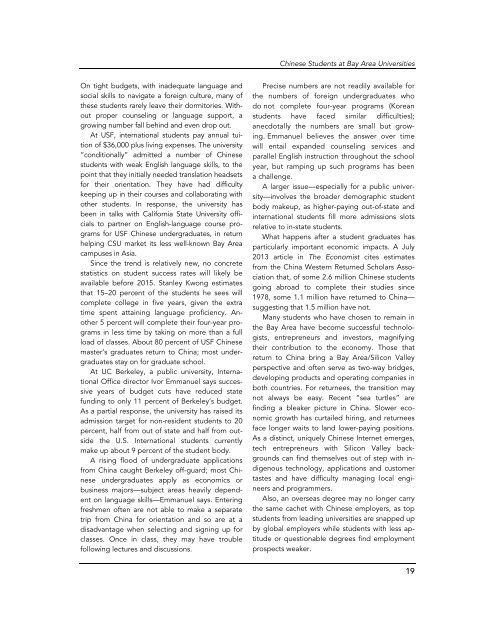Create successful ePaper yourself
Turn your PDF publications into a flip-book with our unique Google optimized e-Paper software.
Chinese Students at Bay Area Universities<br />
On tight budgets, with inadequate language and<br />
social skills to navigate a foreign culture, many of<br />
these students rarely leave their dormitories. Without<br />
proper counseling or language support, a<br />
growing number fall behind and even drop out.<br />
At USF, international students pay annual tuition<br />
of $36,000 plus living expenses. The university<br />
“conditionally” admitted a number of Chinese<br />
students with weak English language skills, to the<br />
point that they initially needed translation headsets<br />
for their orientation. They have had difficulty<br />
keeping up in their courses and collaborating with<br />
other students. In response, the university has<br />
been in talks with California State University officials<br />
to partner on English-language course programs<br />
for USF Chinese undergraduates, in return<br />
helping CSU market its less well-known Bay Area<br />
campuses in Asia.<br />
Since the trend is relatively new, no concrete<br />
statistics on student success rates will likely be<br />
available before 2015. Stanley Kwong estimates<br />
that 15–20 percent of the students he sees will<br />
complete college in five years, given the extra<br />
time spent attaining language proficiency. Another<br />
5 percent will complete their four-year programs<br />
in less time by taking on more than a full<br />
load of classes. About 80 percent of USF Chinese<br />
master’s graduates return to China; most undergraduates<br />
stay on for graduate school.<br />
At UC Berkeley, a public university, International<br />
Office director Ivor Emmanuel says successive<br />
years of budget cuts have reduced state<br />
funding to only 11 percent of Berkeley’s budget.<br />
As a partial response, the university has raised its<br />
admission target for non-resident students to 20<br />
percent, half from out of state and half from outside<br />
the U.S. International students currently<br />
make up about 9 percent of the student body.<br />
A rising flood of undergraduate applications<br />
from China caught Berkeley off-guard; most Chinese<br />
undergraduates apply as economics or<br />
business majors—subject areas heavily dependent<br />
on language skills—Emmanuel says. Entering<br />
freshmen often are not able to make a separate<br />
trip from China for orientation and so are at a<br />
disadvantage when selecting and signing up for<br />
classes. Once in class, they may have trouble<br />
following lectures and discussions.<br />
Precise numbers are not readily available for<br />
the numbers of foreign undergraduates who<br />
do not complete four-year programs (Korean<br />
students have faced similar difficulties);<br />
anecdotally the numbers are small but growing.<br />
Emmanuel believes the answer over time<br />
will entail expanded counseling services and<br />
parallel English instruction throughout the school<br />
year, but ramping up such programs has been<br />
a challenge.<br />
A larger issue—especially for a public university—involves<br />
the broader demographic student<br />
body makeup, as higher-paying out-of-state and<br />
international students fill more admissions slots<br />
relative to in-state students.<br />
What happens after a student graduates has<br />
particularly important economic impacts. A July<br />
2013 article in The Economist cites estimates<br />
from the China Western Returned Scholars Association<br />
that, of some 2.6 million Chinese students<br />
going abroad to complete their studies since<br />
1978, some 1.1 million have returned to China—<br />
suggesting that 1.5 million have not.<br />
Many students who have chosen to remain in<br />
the Bay Area have become successful technologists,<br />
entrepreneurs and investors, magnifying<br />
their contribution to the economy. Those that<br />
return to China bring a Bay Area/Silicon Valley<br />
perspective and often serve as two-way bridges,<br />
developing products and operating companies in<br />
both countries. For returnees, the transition may<br />
not always be easy. Recent “sea turtles” are<br />
finding a bleaker picture in China. Slower economic<br />
growth has curtailed hiring, and returnees<br />
face longer waits to land lower-paying positions.<br />
As a distinct, uniquely Chinese Internet emerges,<br />
tech entrepreneurs with Silicon Valley backgrounds<br />
can find themselves out of step with indigenous<br />
technology, applications and customer<br />
tastes and have difficulty managing local engineers<br />
and programmers.<br />
Also, an overseas degree may no longer carry<br />
the same cachet with Chinese employers, as top<br />
students from leading universities are snapped up<br />
by global employers while students with less aptitude<br />
or questionable degrees find employment<br />
prospects weaker.<br />
19


